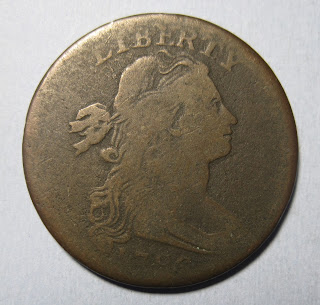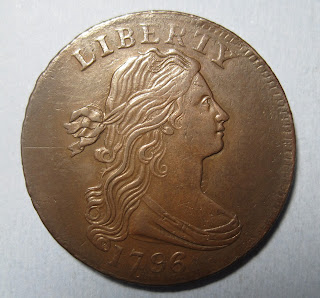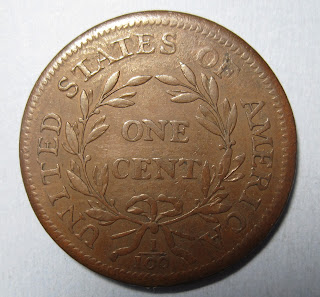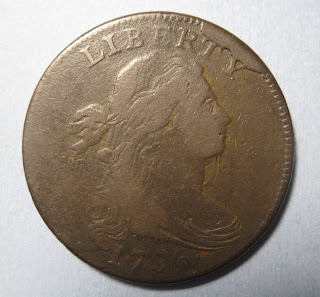I have chosen to call my collection the “Clackamas
Collection” for a few reasons. The Clackamas people comprised one of the tribes
on the lower
While assembling these 1796 cents, I tried to acquire coins with major features visible, good color, reasonably nice surfaces, and minimal problems, while remaining affordable. The challenge of getting all 39 Sheldon varieties for 1796 in acceptable condition has been daunting. Indeed, it required 31 years to complete my basic Sheldon variety set.
1796 LIBERTY CAP cents
S-81. This is a relatively easy variety to find (R3). The date is closely spaced, and very close to the bust. I located this coin on ebay in 2004.

S-82. A scarce variety (R5). This coin was purchased in a Goldberg auction in 2015, and once belonged to the well-known collector / dealer Rod Burress.
S-83. A moderately scarce variety (R4). The date is close to
the bust, with wide spacing between “1” and “7”. This coin was purchased at a
S84. Another somewhat abundant variety (R3). This coin has fairly strong details, but a few light rim bumps. It was purchased in a Goldberg auction in 2016 (Ex. Norman Wolfe).
S85. A scarce variety (R5-) and difficult to find without problems. This coin was purchased in a Heritage auction in AUG 2008. It was then in a NGC F-details holder (Environmental Damage). I have liberated the coin. The surfaces are lightly rough, but the eye appeal remains good.
S87. The variety is not rare (R3). The “6” is typically very weak, due to die failure. This coin, though fairly worn, shows a strong date. It is the first 1796 cent I purchased, from Beaverton Coin back in 1990.
S88. A moderately scarce variety (R4). This coin features
nice details, and lightly “rusted” surfaces. The central rev. is weak, as is
often the case with 1796 Liberty Cap cents. This coin was purchased in 1996
from Jerry Wickwire of
S89. This variety is somewhat plentiful (R3). The date &
S90. Easily the most difficult Liberty Cap variety to locate (R5+). This coin has unusual brick red patina, and surfaces that were “smoothed” at some point. I purchased this coin in a Goldberg auction in FEB 2017, with provenance from the Pierre Fricke collection. Note: The reverse is pictured "upset" because it is 180 degrees rotated on the actual coin.
S91. A relatively common variety (R3). This coin exhibits good detail (except the central rev.), with light roughness on the surfaces. It was purchased in a Bauer on-line auction in 2022.
1796 DRAPED BUST cents
S92. This is not a difficult variety to locate (R3). I purchased this coin in 2015 from Joan & Rod Widock. they, in turn had obtained it in an earlier 2009 Goldberg auction.
S93. Another variety that is somewhat easy to locate (R3). I found this coin in a Stacks/Bowers auction in 2015. The coin was submitted to PCGS, where it graded G6.
S94. This is a tough variety to find (R5+). After a long search, I found this coin in a Heritage auction in JAN 2018. PCGS has graded the coin VG-10. However, the surfaces are dark and heavily granular, leading to an EAC net grade of G4.
S95. A very difficult variety to find (R5+). As so often happens in numismatics, after years of searching for this variety, I got two chances to obtain it within a 30-day period of time! This is the finer of those two coins. There is a touch of reddish patina on the obv., but the eye appeal is above average. This coin was purchased in 2018 from Kevin Vinton.
S96. A very rare coin (R6). This variety is the most
difficult one to locate among all the regular Sheldon-numbered varieties of
1796. The coin I finally located, on ebay in 2021 has acceptable detail
(numbers and letters all clear), but is heavily granular (one could almost say
"rusty"). None-the-less, the coin is a treasured addition to my 1796
set. This was the final variety needed to complete my 1976 “Sheldon set”. It is
an example of the late die-state, with a die crack bisecting the rev. from the
"T" in UNITED to the right side of "M" in
S97. A fairly plentiful variety (R3). This coin was one of
my early finds as a large cent collector. Paul Dorney had a small shop in
S98. A moderately scarce variety (R4). This coin is the 2nd finest 1796 draped bust cent in my collection. This coin has extremely fine sharpness, and superb eye appeal, in spite of being cleaned and re-toned long ago. I purchased it in a Goldberg auction in June 2016. The provenance includes March Wells and can be traced to the 1944 sale of the Howard Newcomb large cents! Truly a historic & important coin.
S99. A scarce variety (R5). This variety presents some
spectacular obv. die breaks in the later stages. My coin is an early die-state,
before the breaks behind the head become evident. The bottom of the date and
the top of
S100. This variety is also scarce (R5). My coin is from a Superior auction in 2004, and is heavily worn, with a touch of roughness on the obv.
S101. A variety of moderate scarcity (R5-). This coin has very nice detail, with relatively smooth dark gray-brown surfaces. One light rev. rim tap, but otherwise a nice example for the grade. I found it in a Heritage auction in 2016.
S102. A moderately scarce variety (R4). This coin has a nice level of detail, with some weakness on the rev. legend noted. The color & surfaces are choice for the grade level. A nice deep chocolate brown. There is a die break noted, through BE to the top of the head. This coin was purchased in a Goldberg auction in June 2016. The coin is graded & encapsulated VG8 by PCGS.
S103. LIHERTY. One of the famous varieties with a
die-cutting error involving the “B” in LIBERTY being first punched in
backwards, then corrected, to make what appears to be a letter “H”. S103 is the
scarcer of the two LIHERTY varieties (R4+). This coin has solid details and
choice surfaces & color, with just one small ding noted at the rim under
the letter “N” in UNITED. I purchased the coin in 1996 from Jerry Wickwire of
S104. LIHERTY. The less scarce variety with the LIHERTY die error (R3). This coin features nice detail, with lightly granular dark steel brown surfaces and a couple trivial rim bumps (obv.). The coin was purchased in a Goldberg auction JUN 2016.
S105. A fairly scarce variety (R5-). I purchased this coin in the annual EAC auction in 2015. The coin is graded & encapsulated AG3 by PCGS.
S106. A moderately scarce variety (R4+). Although the rarity rating is not as high, I found this variety difficult to locate. In 2018 I finally found one that looked decent in an ebay auction. This coin is in a PCGS holder, graded VG Details, Scratched. The scratch is fairly obvious, just left of the lowest curls, but it does not harm the eye appeal too much. The dark brown surfaces are lightly granular.
S107. A very difficult variety to locate in any grade (R5), and especially so in high grade (the top coin in the condition census is just VF-20)! My coin comes from the Stacks / Bowers 2021 sale of the Wm. Woytasek coins. It features good details and minimal problems. The die-state is early, before the cud break develops over the "T" in LIBERTY and to the right.
S108. A variety that is rated R4, but in my experience is not hard to find. This variety has the distinction of having the 1794 style edge dentillation for both obv. and rev. This led Breen to consider it the “first” variety of the draped bust type to be struck in 1796 (I do not agree with his assertion). This coin was purchased from Shawn Yancey in 2005.
S109. An easy variety to locate (R3). However, it's rarity rating is deceptive, since the majority of coins have surface issues or other problems. This coin, which I acquired in a 2021 Heritage auction, illustrates typical surfaces.
S110. Another fairly common variety (R3). This coin is a pretty good representative. The obv. has nice detail, but some scratches are noted in the area around the date. This coin was purchased in the annual EAC auction in 2004 (LOT 104).
S111. Somewhat scarce variety (R5-). This coin exhibits nice details, and original dark steel brown color. One obv. rim bump is noted over "LI" in LIBERTY, but the overall appearance remains pleasing. The coin was purchased in a Goldberg auction June 2016 (LOT 139).
S112. A moderately scarce variety (R4+). This coin has smooth brown surfaces, and very few distracting marks. The central rev. is weakly struck (as often seen). The rev. is also rotated slightly. It was purchased on ebay in 2015.
S113. A very scarce variety (R5) that is most often found with a die break through the date. This coin is an exception, with the die break not evident. The dies appear to have been mis-aligned, because
S114. The guides list this variety as R5-, but I believe it to be more common (R4, at best). A cud die break appears later, at the rim above RTY, but this coin does not show evidence for it. This coin is deep olive green, with granular surfaces, and some evidence of corrosion behind the top of the head. This coin was purchased on ebay in 2016.
S115. An obtainable variety (R3). This coin displays very nice details, and shows an arcing die break behind the date plus a large cud die-break above "TY" in LIBERTY. This coin was purchased in 2009 in the Goldberg auction of the Dan Holmes collection.
S118. An extremely scarce variety (R5+). The only variety with fewer auction appearances than this variety since 2000 is the S96 (an acclaimed rarity). After more than 2 years of diligent hunting for an acceptable coin, this humble specimen was located on ebay in 2018. Although it is only FR2, there are minimal problems, with just a couple small “dark green” spots noted on the rev. rim. This is the ultimate “devotee’s coin”, as only a devoted 1796 fan could appreciate it.













































































